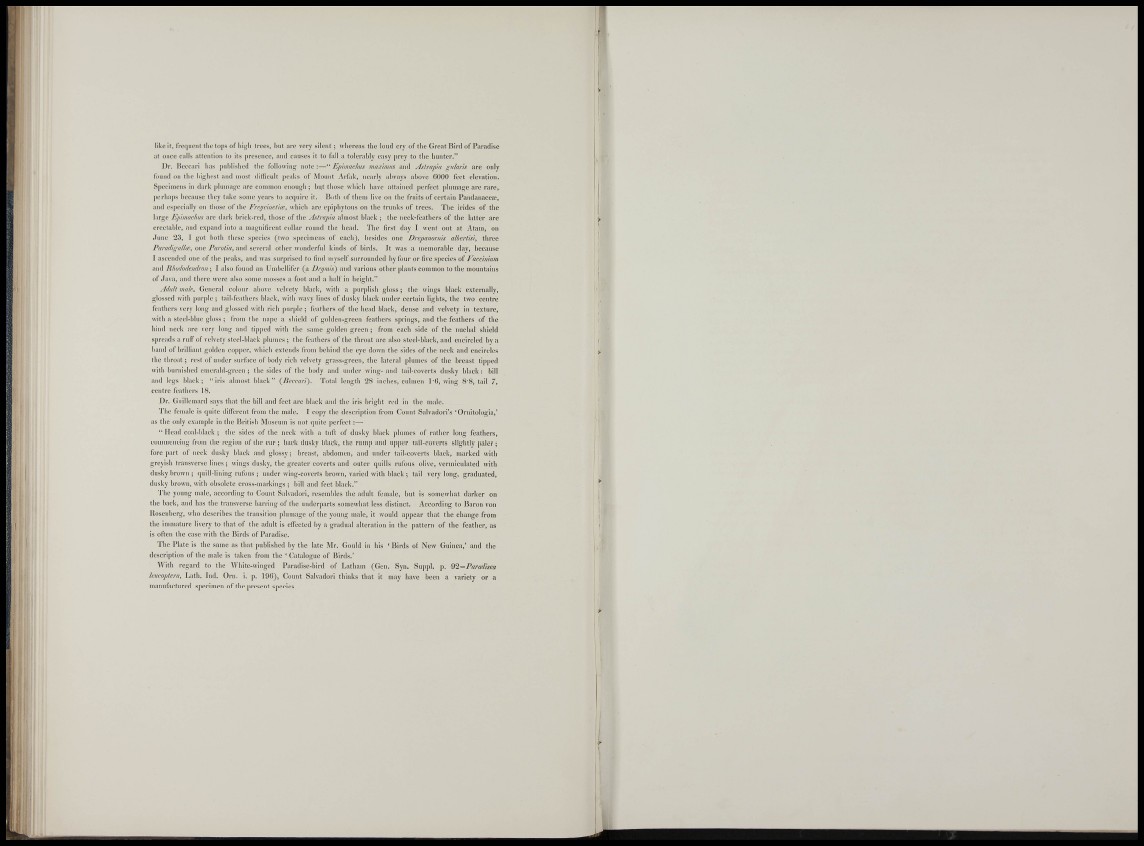
like It, fi eqnoTit tlie tops of liigli trees, l)iit are very silent; whereas the louil er_v of the Great Bird of Paradise
at onee calls attention t.o Its presence, and causes it to fall a tolerably easy prey to tlie hunter."
Dr. lieccai-l has pnhlished the followlni^ note :—" Ephnachus vuuimua and ylstrap'ia guhm are oidy
found on the lilj^hest and most diHiciiIt pealis of .Moinit Arfali, nearly always above GOOO feet elevation.
Speclnien.s In dark jihnnaii^e are eoinnion eiioni^h ; but those u hlch have attained perfect plntiia^e are rare,
perhaps because they take some years to acquire It. lintli of them live on the fruits of certain Paadanaeeffi,
atui especially on those of the Frei/ciuetta;, which are e])iphytous on the trunks of trees. The Irides of the
large Ejiimachus are dark briek-red, those of the Astrapiu almost blaek ; the neck-feathers of the latter are
erectable, ami e.xpand Into a magnlfieent collar round the head. The first day I went out at Atain, on
tJuac 23, I got both these species (two specimens of each), besides one Drepaiwriih alberf'tsi^ three
I'madigalltc, one Pnrottu, and sevci-al other wonderful kinds of birds. It was a memorable day, because
1 ascended one of the peaks, and was surprised to find myself surrounded by four or five species of Faccinlum
and lilio(h(lenclron\ I also found an Umbellifer (a Dy^mis) and various other plants common to tiie mountains
of Java, and there were also some mosses a foot and a half In height."
Adult male. General colour above velvety black, with a purplish gloss; the wings blaek externally,
glossed with j)urple ; tail-feathers black, with wavy lines of dusky black under certain lights, the two centre
feathers very long and glossed with rich purple ; feathers of tlie head black, dense and veh'ety in texture,
with a steel-blue gloss ; from the nape a shield of golden-green feathers si)rlngs, and the feathers of the
liind neck are very long and tipped with the same golden green ; from each side of the tnichal shield
spreads a rnlf of velvety steel-black plumes; the feathers of the throat arc also steel-blaek, and encircled by a
hand of brilliant golden copper, which e.xtenils from behind the eye down the sides of the neek and encircles
the throat; rest of under surface of body rich velvety grass-green, the lateral plumes of the breast tipped
with burnished emerald-green ; the sides of the body and inider wing- and tail-coverts dusky blaek : bill
and legs black; "iris almost blaek" {lieccari). Total length 28 inches, culmen I'G, wing 8-8, tail 7,
centre feathers 18.
Dr. Gulllemard says that the bill and feet are black and the iris bright red In the male.
The female Is quite different from the male. I copy the description from Count Salvadorl's 'Ornltologia,'
as the only example in the Hritish iMnseum Is not quite j>erfect;—
" Head coal-hlaek ; the sides of the neck with a tuft of dusky black plumes of rather long feathers,
commencing from tlie region of the ear ; back dusky black, the rump and upper tail-coverts slightly ])aler ;
fore i)art of neck dusky black and glossy; breast, abdomen, and under tail-eoverts black, marked with
greyish transverse lines ; wings dusky, the greater coverts and outer quills rufous olive, vermiculated with
dusky brown ; quill-lining rufous ; under wing-coverts brown, varied with blaek ; tail very long, graduated,
dusky brown, with obsolete cross-markings ; bill and feet black."
The young male, according to Count Salvadorl, resembles the adult female, but is somewhat darker on
the back, and has the triuisverse barring of the underparts somewhat less distinct. According to Baron von
Rosenberg, who describes the transition plumage of the young male, It would appear that the change from
the iiiiuuiture livery to tliat of the adult Is effected by a gradual alteration In the pattern of the feather, as
is often tlie case with the Birds of Paradise.
The Plate Is the same as that published by tlie late Mr. Gould in Ids ' Birds of New Guinea,' and the
dcscrijition of the male is taken from the ' Catalogue of Birds.'
M'ith regard to the White-winged Paradise-bird of Latham (Gen. Syn. Sup])!, [i. Q'i=Paradisea
kmoptera. Lath. Ind. Orn. 1. p. 190), Count Salvadorl thinks that it may have been a variety or a
nuinufactured speclinen of the present species.